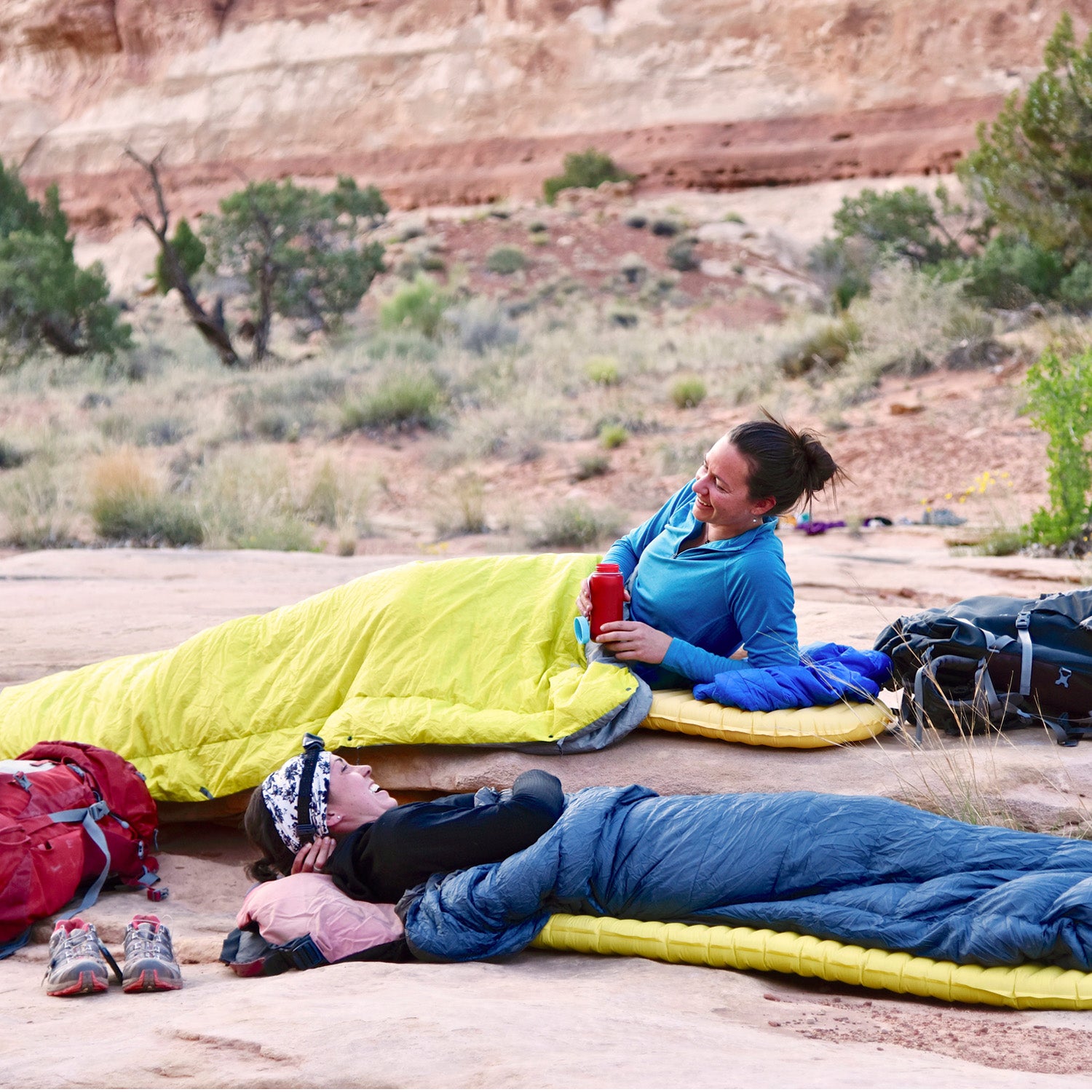Confession: I love my women’s sleeping bag. It’s made by , before 2016, when that company stopped making gendered options for its pinnacle product, the . My 15-degree women’s version weighs less than two pounds, envelops me in a blissful bubble of down, and fits my particular length and girth. That last detail is crucial, because sleeping in a too-tight mummy bag ranks as its own circle of hell.
Most companies still make separate sleeping bags for women and men (Mountain Hardwear still offers many women’s bags). But there are signs that, like gender-specific restrooms in some parts of the country, women’s sleeping bags may be on the way out. Led by new initiatives from REI, major brands from The North Face to Big Agnes are debating whether gendered bags do an adequate job of keeping a diverse range of backpackers comfortable—and if using the still widely-accepted binary labels is necessary in a world that seems to be moving away from them. Although companies haven’t officially axed women’s models entirely from their product lineups, many are moving to gender-neutral lines that could serve male, female, and nonbinary-identifying backpackers across the board—which may ultimately mean the end of women’s-specific sleeping bag design.
When the first women’s sleeping bag hit the market in 1995, it was heralded as an empowering piece of gear. Made by Sierra Designs, the 20-degree Calamity Jane was the brainchild of company president Sally McCoy, who had climbed some of the world’s highest mountains and felt poorly served by bags built for men. Her women’s bag was narrower through the shoulders but wider at the hips, shorter in length (it came in 5’ 5” and 5′ 10” options), and generously insulated with beefed-up padding in the core and footbox. Women took its existence as a sign of their inclusion within the male-dominated outdoor culture—and sales soared.
Inspired by the success of Calamity Jane, a flood of companies brought women’s bags to market and promoted shorter lengths, hip-accommodating widths, and extra insulation. European Norm (EN) ratings for sleeping bags, established in 2005, confirmed through repeated independent testing McCoy’s suspicion that women sleep colder than men on average (although the specific science is still fuzzy) and allowed manufacturers to publish gendered comfort ranges for their sleeping bags. REI embraced the system, and by 2010, the retailer required all brands that manufactured mummy-style bags to reveal the product’s EN rating. Instead of making one unisex bag that didn’t appear to perform as well for women, manufacturers doubled down on gendered bags.
But, as with the ongoing dialogue about traditional gender labeling in everything from political language to high fashion, future product lines suggest a new, less binary direction. When The North Face presented its spring 2023 line to the media in September, women’s bags were part of the assortment—but TNF’s rep also forecast that it might be the brand’s last year making them. NEMO is another sleeping bag manufacturer that’s reevaluating the concept of women’s bags.
“There’s currently a lot of discussion among brands and retailers about the future of gendered bags and whether gender-neutral options might serve campers better,” says Mike Welch, NEMO’s vice president of global sales.
Why the sudden sea change? TNF says that REI is urging brands into the new approach with sleeping bags—one that saves shoppers from having to identify as either male or female and still have a bag that keeps them comfortable at night.
“It’s ironic, since REI was behind the creation of women’s bags in the first place,” notes Tim Beck, TNF’s sleeping bags category manager. Indeed, REI’s influence on the outdoor industry can’t be overstated: Given the retailer’s vast scale, it drives the trends that other brands follow. When REI declares a new direction for gendered sleeping bags, it’s a big deal.
Case in point: For spring 2023, REI is introducing a gender-neutral line of backpacking gear and apparel that’s across gender, budget, and body size. The Trailmade 20 sleeping bag won’t be sold in men’s and women’s versions. But it will come in three lengths with a wide-cut option for each, for a total of six possible fits per temperature rating.
“We didn’t want people to have to choose bags based on their gender, ” says Derek Temple, REI’s camp category merchandise manager. The every-body Trailmade bags allow shorter-than-average men to purchase the right-fitting bag without feeling like they’re getting gear built for women, or allow non-binary shoppers to bypass uncomfortable questions. (Admittedly, some women about the need for gendered bags.)
For now, REI expects to keep selling women’s-specific bags for as long as demand continues.
“We do a strong women’s-specific business,” says Courtney Gearhart, REI’s senior public affairs program manager. But offering women’s models while also developing a broad size-inclusive unisex range creates a glut of sleeping bags—so campers’ purchases over the coming year will likely determine whether women’s bags stay or go.
REI, along with other brands with growing all-gender lines, like Big Agnes, haven’t determined how their new bags will represent the formerly-gendered temperature ratings. “Comfort” ratings (the temperature threshold for cold sleepers) currently appear on women’s bags, while “limit” ratings indicate the temperature range for warm sleepers and appear on bags that have historically been marketed at men. Test standards for gender-neutral bags don’t yet exist. And although brands aren’t required to use standards verified by the EN or the International Organization for Standardization (ISO is another third-party regulator), these guidelines have become a key factor in how brands market bags—and how campers buy them.
Consequently, NEMO won’t make firm decisions about gendered bags until it can work out a fair and understandable way to represent temperature ratings. Says Welch, “NEMO is focused on presenting options that create the best shopping experience by speaking clearly about temperature ratings across all bags.”
Campers aren’t likely to know whether women’s bags will remain on the market until 2024 or beyond. In the meantime, people who identify as female—and who want a women’s-specific sleeping bag—might want to start shopping now. And as brands work out temperature ratings for non-gendered bags, these new models may do what women’s bags did decades ago: validate participants’ inclusion in the outdoor realm, while making the actual experience more enjoyable too.


